





To support our efforts please browse our store (books with health benefits, etc.).
The species within genus Chenopodium are difficult to distinguish between. They often include several varieties whose identification usually requires the use of a microscope. One of the important distinguishing characters is the texture of the seed-coat. Oak-leaved goosefoot has gained its name from the shape of its leaves which resemble that of many oaks. Oak-leaved goosefoot is an annual that flourishes in nitrogen-rich soil.
Distinguishing Features
The specific epithet glaucum originates from the bluish-green underside of the leaves, which is caused by a dense covering of hairs. The stem is hairless and can be green or red-striped. Chenopodium glaucum is an annual.
Flowers
The flower has individual floral spikes that are up to 4cm long; there are several small flowers per cluster. Some flowers may have pedicels up to 0.5 mm. long. Each mature flower is about 2 mm. across, consisting of 3-5 greenish sepals, 3-5 stamens, and a pistil with a pair of styles; there are no petals. The sepals are lanceolate to ovate, bluntly tipped, and glabrous. The stamens protrude outward with yellow anthers. It blooms from June to September, and the seeds ripen from August to October.
 Fields
of Nutrition has medicinal benefits and vitamin/mineral content of Oak Leaf Goosefoot.
Fields
of Nutrition has medicinal benefits and vitamin/mineral content of Oak Leaf Goosefoot.
Leaves
The leaves are simple (lobed or unlobed nut not separated into leaflets). They are alternate and there is one leaf per node along the stem. The edge of the leaf blade has teeth. The petioles are up to 2cm. long; light green to yellowish red, and glabrous. The under part of the leaves are farinose (covered with fine granular or mealy coating).
Height
This plant grows anywhere between 7 and 40 cm in height.
Habitat
Oak-leaved Goosefoot grows anywhere in which the soil is nitrogen-rich. It may appear in gardens, on manure heaps, or in waste areas.
Edible Parts
The leaves are edible in small quantities and the seeds can also be consumed but only if they are soaked in water overnight to remove the saponins.
Other Name
Oak Leaved Goosefoot.
Similar Plants
Chenopodium album.
Winter Survival Food Handbook

PDF Plant Magazines
Types of Wild Food
Geographic Zones Seasons
Disclaimer
EdibleWildFood.com is informational in nature. While we strive to be 100% accurate, it is solely up to the reader to ensure proper plant identification. Some wild plants are poisonous or can have serious adverse health effects.
We are not health professionals, medical doctors, nor are we nutritionists. It is up to the reader to verify nutritional information and health benefits with qualified professionals for all edible plants listed in this web site. Please click here for more information.
Why Edible Wild Food?
- Food costs are rising
- Free, wild food is readily abundant
- Wild food adds nutrition to your diet
- Wild food can help treat various medical conditions





